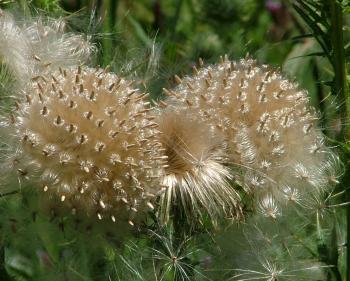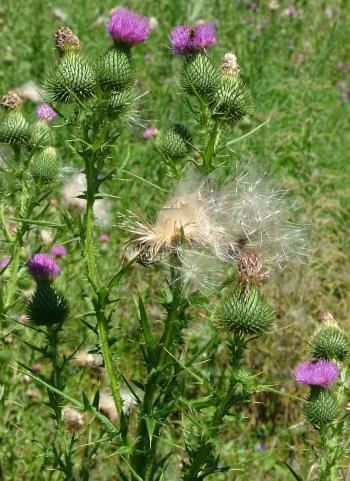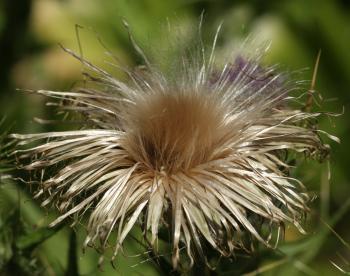Cirsium vulgare
Cirsium vulgare (Savi) Ten.
Family: Asteraceae
Common names: Scottish thistle, spear thistle (Eng.); skotse dissel (Afr.); hlaba (Sesotho); ntsoa-ntsane (Setswana)
Introduction
Cirsium vulgare is mostly regarded as a weed or undesirable plant. However, the plants are very attractive and offer lots of rewards for butterflies and other insects, and despite the very sharp thorns on the leaves, it also has some uses for humans.

Description
Description
A spiny, herbaceous, biennial plant, with a large basal rosette of leaves, a deep taproot and a flowering stem growing from the centre of the rosette, up to 1.5 m high. The stems have spiny wings and branch in the upper parts. Leaves are dark green, with stiff hairs above, white woolly below, deeply lobed, with the lobes ending in strong spines.

Young flower heads are teardrop-shaped, with 10 to 12 series of green, spiny bracts, curling outwards. The flowers are all tubular, purplish pink.

Achenes are about 4 mm long and 1.5 mm wide, with many rows of silky-plumed pappus bristles, about 20 mm long. The bristles are often interlocked and the pappus and seed are often distributed in a cluster.
Plants flower during summer, from September to April.
Conservation Status
Status
Cirsium vulgare is an introduced, naturalized, invasive species in South Africa and has not been assessed for the Red List of South African plants.
Distribution and habitat
Distribution description
Cirsium vulgare is distributed throughout the country. It is a ruderal species, which are the first to colonize disturbed areas. it is found in grassland or forested areas, overgrazed lands, pan and dam edges and river banks, vacant fields, burnt areas, roadsides, construction sites or any disturbed sites, in moist, as well as dry conditions.

Derivation of name and historical aspects
History
The name Cirsium is derived from the Greek word kirsos, meaning ‘swollen vein’, which refers to thistles being used as remedy against swollen veins. The species name, vulgare, is from the Latin meaning ‘common’.
This species is originally from Europe, but is now spread as a weed of cultivation in South Africa. It is thought to have been introduced from Europe with imported fodder during the Anglo Boer Wars.
Ecology
Ecology
This plant is undesirable and unpalatable to most grazing animals. It is, therefore, very visible in heavily grazed fields because it may be the only plant remaining.
The flowers of Cirsium vulgare are a rich source of nectar and pollen. It is utilized by various insects, such as beetles, honey bees, bumble bees, hoverflies and many butterflies.
Seeds are dispersed by wind, animals, mud, water, and sometimes by ants. Human activities such as bailing or harvesting can also aid the dispersal of seeds.

Uses
Use
Although the leaves, stems and roots are edible and can be used cooked as a vegetable or fresh in salads, it is almost not worth the effort. The spines need to be removed, and after this tedious process very little remains to be used. The flowers resemble tiny artichokes, but are even more of an effort to clean and then produce a very bland heart.
A mixture of the soaked leaves and roots of the Cirsium vulgare is used as a medicine to heal a stiff neck, seizures, as well as nervous disorders.
The boiled leaves can act as an effective diuretic and mildly drains the liver, as well as provides comfort when fevers are caused by an overworked liver.
The boiled mixture of the whole plant is used traditionally to treat rheumatic joint pains and also to heal bleeding piles. The boiled roots mixture of the plant is used as a poultice to treat aching jaws.
The roots are also reported to be effective in lowering blood sugar and cholesterol levels, and also reduce blood pressure. Roots are also used for muscular inflammation.
The oil from the seeds extracted by means of cold press, is used for cooking and as a lamp oil.
Growing Cirsium vulgare
Grow
Cirsium vulgare prefers fertile soil that consist of loam, clay loam or that is slightly stony. It is generally intolerant of shade and is nearly absent if light intensity is reduced to less than 40%. However; growing this plant is not encouraged since it is declared weed, Category 1b in South Africa. It should rather be removed.
The best way to control the spread of Cirsium vulgare is by mechanically or manually digging up the plants before they flower. Flower heads have the ability to mature seeds after they are cut, so proper disposal of plant material is important. Ideally the plants should be burnt. If plants are not removed completely, cutting of stems may need to be repeated throughout the season to prevent secondary flowering.
References
- BioNET-EAFRINET, Keys and Fact Sheets. Cirsium vulgare (Spear Thistle). http://keys.lucidcentral.org/keys/v3/eafrinet/weeds/key/weeds/Media/Html/Cirsium_vulgare_(Spear_Thistle).htm. Accessed 2017-04-17.
- CABI. Invasive Species Compendium. Cirsium vulgare (spear thistle) http://www.cabi.org/isc/datasheet/13631. Accessed 2017-04-17.
- Forcella, F. & Randall, J.M. 1994. Biology of Bull Thistle, Cirsium vulgare (Savi) Tenore. Reviews of Weed Science 6: 29–50.
- Henderson, L. 2001. Alien weeds and invasive plants. A complete guide to declared weeds and invaders in South Africa. Plant Protection Research Institute Handbook No. 12, 300 pp. PPR, ARC South Africa.
- Hilliard, O.M. 1977. Compositae in Natal. University of Natal Press, Pietermaritzburg.
- Interactive Flora of nw Europe: Cirsium vulgare http://ip30.eti.uva.nl/bis/Flora.php Accessed 2016-09-21
- Invasive Species South Africa. Spear Thistle, Cirsium vulgare. http://www.invasives.org.za/legislation/item/225-spear-thistle-cirsium-vulgare. Accessed 2017-04-17.
- Klinkhamer, P.G.L & De Jong, T.J. 1993. Cirsium vulgare (Savi) Ten.: (Carduus lanceolatus L., Cirsium lanceolatum (L.) Scop., non Hill). Journal of Ecology 81: 177–191.
- Swanepoel, D.P. 1997. The medicinal value of the southern African Asteraceae. M.Sc. dissertation. Pretoria: University of Pretoria. South Africa: 116.
- Zimmerman, J.A.C. 1997. Ecology and distribution of Cirsium vulgare (Savi) Tenore, Asteraceae. USGS Southwest Exotic Plant Mapping Program. Internet 1/21/99. Available: http://www.usgs.nau.edu/swemp/
Credits
Millicent Ndou & Marinda Koekemoer
National Herbarium, Pretoria
May 2017
Plant Attributes:
Plant Type: Bi/Annual
SA Distribution: Eastern Cape, Free State, Gauteng, KwaZulu-Natal, Limpopo, Mpumalanga, North West, Northern Cape, Western Cape
Soil type: Clay, Loam
Flowering season: Early Summer, Late Summer
PH: Neutral
Flower colour: Purple, Pink
Aspect: Full Sun, Morning Sun (Semi Shade), Afternoon Sun (Semi Shade)
Gardening skill: Easy
Special Features:
Horticultural zones











Rate this article
Article well written and informative
Rate this plant
Is this an interesting plant?
Login to add your Comment
Back to topNot registered yet? Click here to register.